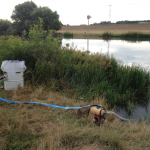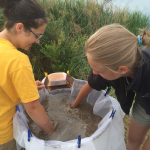Blog post by Kayla Pio
No, thats not a washing machine or some gold-mining contraption. That is our lovely flotation machine here at the BAKOTA project. It helps us collect burned prehistoric seeds and wood.
This material is usually too small to recover during excavation. However, because these botanical remains have very low densities, they float and become almost instantly visible in basins of water. In order to work, one needs to efficiently get the soil, which desperately clings to this material and weighs it down, broken up and detached.
Thats where the flotation machine comes in and works its magic–at least, when its engine is in the mood to actually do its job. However, before I begin my rant about the mechanics, lets see how the process actually works once everything is in working order.
As you can see, the flotation machine is made out of a large, used oil drum. Inside, a sprinkling system sits in the middle of the drum and is hooked up to a pump. The soil sample is poured above this sprinkler onto a large mesh.
Once the water begins to be pumped through the system, it will gently move the soil from below. This can be a lengthy process, though. To help the sprinkler, we gently stir the water (think of stirring a yummy Hungarian goulash.)
After 20 minutes or so, the seeds, wood, and roots (together called the light fraction), should be separated from any heavy material that was stuck in the clumps of soil (mainly small bone and ceramic fragments). Our light material will be visible at the top of the drum, eager for collection. To gather the material, we just raise the water level and let the top layer of the water slowly pour out into a small screen (the yellow container outside of the basin in the picture) that has a tightly woven mesh lain inside. Our heavy material (AKA the heavy fraction) stays in the large mesh, which is also gathered up.
And its as easy as that! Or, at least in theory. Then you come face-to-face with our stubborn, picky engine, and its a different story. Luckily, some knowledgeable locals, fluent in engine, were able to tell us exactly what the old pump wanted (which, I should add, was completely different from what the manufacturers suggested).
Of course, even after their help there was still a great deal of experimentation and mishaps, including my own shameful slip into the river (I was only warned to be careful maybe a hundred times).
Once you get the pump finally going, issues may still surface, like, for instance, with the water pressure…



